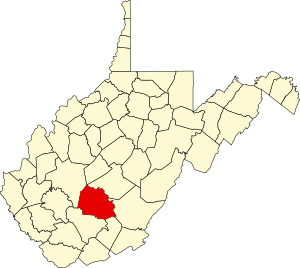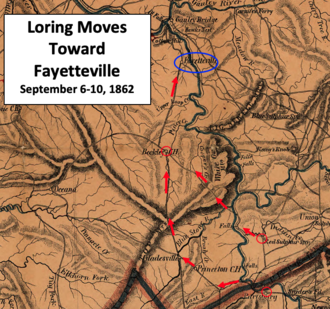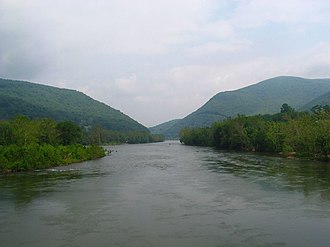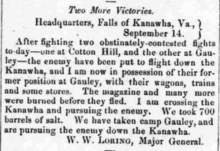
The U.S. state of West Virginia was formed out of western Virginia and added to the Union as a direct result of the American Civil War, in which it became the only modern state to have declared its independence from the Confederacy. In the summer of 1861, Union troops, which included a number of newly formed Western Virginia regiments, under General George McClellan, drove off Confederate troops under General Robert E. Lee. This essentially freed Unionists in the northwestern counties of Virginia to form a functioning government of their own as a result of the Wheeling Convention. Prior to the admission of West Virginia the government in Wheeling formally claimed jurisdiction over all of Virginia, although from its creation it was firmly committed to the formation of a separate state.
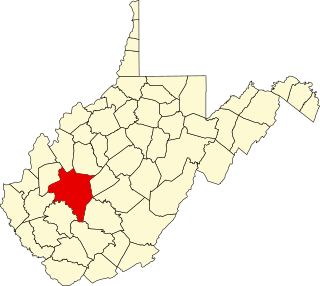
The Battle of Charleston was a Confederate victory in Kanawha County, Virginia, on September 13, 1862, during the American Civil War. Troops led by Major General William W. Loring defeated a Union force led by Colonel Joseph Andrew Jackson Lightburn. This battle, which featured extensive use of artillery but few casualties, was the second major fight in Loring's Kanawha Valley Campaign of 1862 that succeeded in driving Union forces out of the Kanawha River Valley. All points in the Kanawha River Valley were in the southwestern part of Virginia at the time of the battle, but are now part of the state of West Virginia. This battle should not be confused with other battles with similar names that occurred in Charleston, Missouri, and South Carolina's Charleston Harbor.

The Battle of Droop Mountain occurred in Pocahontas County, West Virginia, on November 6, 1863, during the American Civil War. A Union brigade commanded by Brigadier General William W. Averell defeated a smaller Confederate force commanded by Brigadier General John Echols and Colonel William L. "Mudwall" Jackson. Confederate forces were driven from their breastworks on Droop Mountain, losing weapons and equipment. They escaped southward through Lewisburg, West Virginia; hours before a second Union force commanded by Brigadier General Alfred N. Duffié occupied the town.
The 9th West Virginia Infantry Regiment was an infantry regiment that served in the Union Army during the American Civil War.

The 2nd West Virginia Cavalry Regiment served in the Union Army during the American Civil War. It was organized in Parkersburg, Virginia during September 1861. Most of the original members of this regiment were from southeastern Ohio, and planners thought that this regiment would become the 4th Ohio Cavalry. Their application was rejected by the governor of Ohio, so the unit became the 2nd Regiment of Loyal Virginia Volunteer Cavalry. The "Loyal Virginia" part of the name was replaced with "West Virginia" after the state of West Virginia was officially admitted to the Union in 1863. Today, the National Park Service lists them as 2nd Regiment, West Virginia Cavalry under a heading of Union West Virginia Volunteers.

The 22nd Virginia Infantry Regiment was an infantry regiment from the western Virginia that served in the Confederate States Army during the American Civil War. Its commander was George S. Patton Sr., the grandfather of World War II General George S. Patton.

Joseph Andrew Jackson Lightburn was a West Virginia farmer, soldier and Baptist Minister, most famous for his service as a Union general during the American Civil War.
The Kanawha Division was a Union Army division which could trace its origins back to a brigade originally commanded by Jacob D. Cox. This division served in western Virginia and Maryland and was at times led by such famous personalities as George Crook and Rutherford B. Hayes.
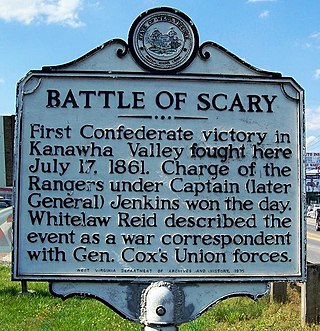
The Battle of Scary Creek was a minor battle fought during the American Civil War across the Kanawha River from present day Nitro in Putnam County, West Virginia on July 17, 1861.

The 45th Virginia Infantry Regiment was an infantry regiment raised in the Commonwealth of Virginia for service in the Confederate States Army during the American Civil War. It fought mostly in the mountainous area that today encompasses the border regions of Virginia and West Virginia, and was part of Jubal Early's Army of the Valley during the Valley Campaigns of 1864.
The 37th Ohio Infantry Regiment was a Union Army regiment, composed of German-Americans, in the American Civil War. It was organized in the fall of 1861, under Colonel Edward Siber, and served in the Kanawha Valley until December 1862. It joined the Union army operating against Vicksburg, Mississippi, in January 1863, and participated in the various engagements of the siege. After the fall of that stronghold it was moved across Tennessee from Memphis to Chattanooga, and took part in operations of the 15th Corps, subsequent to, and at the taking of Atlanta, Georgia. It then followed the fortunes of that well-known corps until the reaching of Washington, D.C. From Louisville, Kentucky, it went with the 2nd Division of the Corps to Little Rock, Arkansas, and was there mustered out in August 1865.
The following Union Army and Confederate Army units and commanders fought in the Battle of Carnifex Ferry of the American Civil War on September 10, 1861, in Nicholas County, Virginia.
The western Virginia campaign, also known as operations in western Virginia or the Rich Mountain campaign, occurred from May to December 1861 during the American Civil War. Union forces under Major General George B. McClellan invaded the western portion of Virginia to prevent Confederate occupation; this area later became the state of West Virginia. West Virginians on both sides would fight in the campaign while a Unionist convention in Wheeling would appoint their choice for a Unionist governor for Virginia, Francis H. Pierpont, and promote the creation of a new state in western Virginia. Large scale Confederate forces would gradually abandon the region, leaving it to small local brigades to maintain hold on southern and eastern sections for much of the war.

William Henry Powell was an American soldier who fought for the Union in the American Civil War. He was a leader in the iron and nail business before the war, and his leadership abilities proved useful in the military. Powell began as a captain, and quickly ascended to higher roles in the cavalry, including commanding a regiment, a brigade, and then a division. Powell was awarded his country's highest award for bravery during combat, the Medal of Honor, for heroism at Sinking Creek, Virginia, when, as leader of a group of 22 men, he captured an enemy camp and took over 100 prisoners. This was accomplished without the loss of any of his men on November 26, 1862. He was honored with the award on July 22, 1890.

The Battle of White Sulphur Springs, also known as the Battle of Rocky Gap or the Battle of Dry Creek, occurred in Greenbrier County, West Virginia, on August 26 and 27, 1863, during the American Civil War. A Confederate Army force commanded by Colonel George S. Patton defeated a Union brigade commanded by Brigadier General William W. Averell. West Virginia had been a state for only a few months, and its citizens along the state's southern border were divided in loyalty to the Union and Confederate causes. Many of the fighters on both sides were West Virginians, and some were from the counties close to the site of the battle.

The Battle of Lewisburg occurred in Greenbrier County, Virginia, on May 23, 1862, during the American Civil War. A Union brigade commanded by Colonel George Crook soundly defeated a larger Confederate force commanded by Brigadier General Henry Heth. Panicked Confederate forces escaped by crossing and burning a bridge across the Greenbrier River.

The Kanawha Valley Campaign of 1862 was Confederate Major General William W. Loring's military campaign to drive the Union Army out of the Kanawha River Valley during the American Civil War. The campaign took place from September 6 through September 16, 1862, although an important raid that had impact on the campaign started on August 22. Loring achieved success after several skirmishes and two battles, and Union troops retreated to the Ohio River and the safety of the state of Ohio.

The 23rd Virginia Infantry Battalion, often called "Derrick's Battalion", was an infantry battalion in the Confederate Army during the American Civil War. It fought mostly in western Virginia and the Shenandoah Valley, and was usually part of a brigade commanded by John Echols or George S. Patton. By 1864, the brigade was usually part of a division commanded by Major General John C. Breckinridge or Brigadier General Gabriel C. Wharton. Do not confuse this battalion with the 23rd Virginia Infantry Regiment that fought mostly in eastern Virginia as part of the Army of Northern Virginia.
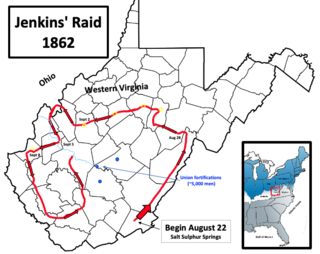
Jenkins' Trans-Allegheny Raid was a Confederate cavalry expedition in the American Civil War that took place in Western Virginia and Ohio during August and September 1862. The raid was led by Brigadier General Albert G. Jenkins, and it started on August 22 as a preliminary step in Confederate Major General William W. Loring's military campaign to drive the Union Army out of the Kanawha River Valley. That campaign, known as the Kanawha Valley Campaign of 1862, took place from September 6 through September 16. The purpose of Jenkins' raid was to get behind the Union army outposts located near the beginning of the Kanawha River, and cut off their main route of retreat to the safety of Ohio.
